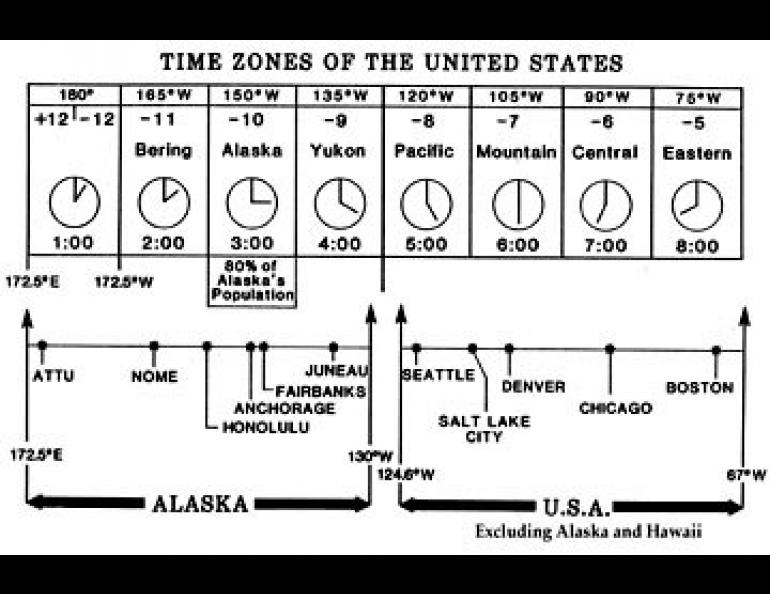
Time Zones
The subject of time zones has once again attracted attention from the Alaska Legislature. Therefore, information on time zones is timely. The drawing summarizes the eight time zones spanned by the United States.
The earth rotates on its axis a full 360 degrees in 24 hours. Therefore, the sun appears to move at a rate of 15 degrees per hour and local time varies from place to place as one moves east or west. An international system of 24 time zones was established in 1884 to avoid the inconvenience of numerous differences in local times. Standard time is defined to be the same everywhere within a zone--a sharp difference of one hour exists when one moves to the next zone but minutes and seconds remain the same.
Each time zone spans 15 degrees of longitude. The "zero" zone is centered on the Prime Meridian which passes through Greenwich, England; it extends east to 7.5°E and west to 7.5°W. The zones are numbered negatively to the west and positively to the east of Greenwich. Some time zones are named as well as numbered. The easternmost time zone in the U.S. is centered on the meridian 75°W, extends from 67.5°W to 82.5°W, is numbered "-5" and is better known by its name "Eastern Standard Time." The center meridian of each zone is shown on the diagram together with its number and name; the clocks show relative time in the eight U.S. time zones.
The boundary between the Pacific and Yukon time zones is at 127.5°W. It is accentuated in the diagram because it lies directly in the middle of the U.S. time zones. Alaska's eastern extreme, at 130°W, lies west of this boundary. Alaska Standard Time, centered on the 150°W meridian, is also known as Hawaii Standard Time--it is numbered "-10."
Alaska spans 57.5 degrees of longitude (four time zones), which is almost exactly the same as the 57.6 degrees between Maine and Washington, thus the "South 48" also span four time zones. Alaska includes the International Date Line, but by custom this boundary is bent to the outer edge of the Aleutian Islands. The westernmost time zone, centered on 180°, and extending from 172.5°W to 172.5°E, is numbered +12 and -12 because it is the twelfth zone east and west of Greenwich. Bering Standard Time is extended one zone west by custom, so this 12th zone is unnamed and not used in Alaska, which is the only state lying partly in the Eastern Hemisphere.
The problem with time zones that bothers people in Alaska arises because a fifth time zone (Pacific) is being used in the state. Pacific Standard Time is used in part of the Yukon zone; yet no part of Alaska lies in the Pacific Standard Time zone. A consequence is the artificial introduction of an extra hour time difference between part of Southeast Alaska and the bulk of Alaska's population which lies west of it. In particular, this is responsible for the two-hour time difference where there should be only one between Juneau and Anchorage/Fairbanks; this annoys people and has precipitated concern by the Legislature.
The introduction of Pacific time in Alaska was related to defense concerns during World War II and the military desire to have Juneau on the same time as Seattle and San Francisco. Now that Southeast Alaska wants to emphasize its strong ties with the rest of Alaska rather than the "Remote 48" (especially after the last vote on moving the capital), the subject of going back to its proper time zone is again an issue. One of the proposals being considered would put all of Alaska on its easternmost time zone (Yukon Time). As can be seen in the diagram, this would be equivalent to putting all of the coterminous U.S.A. into its easternmost time zone (Eastern Time). Thus from Boston to Seattle, i.e., cost to coast, there would be only Eastern Standard Time.





